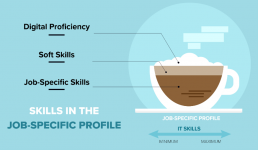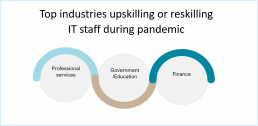Coffee Brewing: Make the Right Cup of Skills to Stay Awake in the Future
IT skills and digital proficiency are both referred to as digital skills — but they are very different. Some confusion may arise from the fact that both require the ability to work with computers. Both are also essential in companies undergoing digital transformation.
The COVID-19 pandemic has embedded digital technologies even deeper into our daily lives. Activities like banking, filing our taxes, obtaining legal certifications, even reserving a hairdresser have been pushed online to an unprecedented extent in response to the lockdowns. This has required most of us to improve our digital proficiency.
Classroom instruction and after-school activities conducted online during the pandemic boosted kids’ digital proficiency. One result is that youngers are well fertilized for future IT skills acquisition.
Seeking to capitalize on this opportunity, Lego and Universal Music Group recently partnered to create the Lego Vidiyo product line. The platform enables children to traverse the physical and digital worlds using augmented reality technology. Users can choose a song and produce a music video featuring digital effects.
Digital Proficiency vs. IT Skills
A rising number of institutions and job recruitment teams are assessing the digital skills of applicants. But what are these?
IT skills are used in the administration, deployment, and delivery of information technologies, including applications, information access tools, application development platforms, security, IT system management, network management, and cloud infrastructure.
Digital proficiency is complementary skills. It involves the use of business, commercial, or consumer applications and tools like word processing, spreadsheets, business and desktop graphics, email, and collaboration tools. Digital proficiency is like adding sugar to coffee or tea. In this case, it adds valuable skills to a specific job.
Whether you are an accountant, a lawyer, or even a psychologist, you need some degree of digital proficiency to function in this era of digital transformation.
IT skills and digital proficiency have different learning time frames. They have different practice requirements.
IT skills can be verified by certification. They are not generic. They usually mandate logical and algorithmic thinking and some math or physics. The need for ones varies in importance depending on the job or they can even do not exist.
Why Should We Distinguish Digital Skills?
The new working models emerging in the wake of the COVID-19 crisis demand an arsenal of new skill sets.
Before the COVID-19 outbreak, it was common to describe job role requirements by hard technical skills and soft skills in general, but acceleration in digital transformation has changed this view. In the new working model, many jobs require digital proficiency in addition to them.
Managing online collaboration and communication technologies — administering online events, working on shared documents, or troubleshooting computers with an online IT help desk — are examples of digital proficiency.
As companies accelerate their digital transformation, they will require a higher degree of digital proficiency. Thus, they need to assess their digital proficiency requirements and build such skills as are crucial for their digital transformation journey.
Training employees with the relevant digital proficiency might appear straightforward, but it should not be overlooked, as it could be a stumbling block to digital transformation. IT skills, on the other hand, are very specific and may pose even greater challenges.
In Future of Work paradigms, in particular, IT skills are critical for specific jobs. For example, an employee who is not an IT specialist may be called upon to write code in one of the low-code/no-code programming languages.
Demand for IT Skills Rising
Our recently updated Technology Employment Impact Guide reports that organizations in Europe will demand more than 11.4 million IT professionals in 2021. The highest growth in demand will be seen for professionals with machine learning, design, or data analyst knowledge.
Our European Industry Acceleration survey, released in May 2020, found that just 6% of companies have reduced skilled IT staff in the last 12 months. On average, 24% of companies hired new skilled IT staff, mainly in the professional services, finance, and telco/media verticals.
Most of the new hires were specialists in cybersecurity, IT infrastructure and operations, or software development. Note, however, the difference between Western Europe and Central and Eastern Europe. In Western Europe, 27% of companies hired new IT skilled staff; in Central and Eastern Europe, only 14% did.
As digital transformation moves forward, companies realize they need a new skill sets and competencies. Companies shouldn’t underestimate investments in people skills and capacities.
Since the onset of the COVID-19 crisis, 36% of Western European companies and 22% of Central and Eastern European companies have invested in reskilling or upskilling staff. Unsurprisingly, cybersecurity, IT infrastructure and operations, and software development are the top areas for staff upgrades.
Organizations in professional services, government, education, and finance are investing the most in reskilling/upskilling as they seek to maximize the benefits of new technologies.
Be Ready for the Skills’ Gap
Digital proficiency, in combination with soft skills (e.g., the ability to organize, lead a team, or write persuasively) have indispensable role for an organization. Employers should work to boost the number of employees with such skill sets.
They must also plan for the future carefully as current workforce demographics indicate a gap in the IT skills market: The number of employees retiring is much higher than the number of candidates applying for jobs.
It is not clear when educational systems will start producing enough IT experts to satisfy market demand. Organizations should consider collaborating with educational institutions to recruit graduates who have the skills that will help drive company growth in uncertain times.
To learn more about our upcoming research, please contact Soheyla Mirshahi or Ivana Slaharova, or head over to https://www.idc.com/eu and drop your details in the form on the top right.




